It has taken me forever to get this post written, at least partially because of the Blogger hiccups of the last couple of days. More, though, I am not even sure how to approach this topic again. The TransLink consultation process on the United Boulevard Extension is wearing me down. Like many others, I am finding it frustrating.
TransLink is holding these consultations for good reasons. They want the best possible plan to take to New Westminster City Council, to maximise their chances of getting this thing approved and built. However, during all of this polishing of concepts, engagement of the local residents, planning, visioning, and conversing, they continue to miss the main point. The more that talk about alternate orientations, noise abatement walls and pedestrian overpasses, the more they avoid the real issues that got them into this mess. It wasn’t the colour of the noise abatement wall that caused New Westminster City Council to send them back to the drawing board in late 2010, it was the lack of a justification for the project in light of the negative impacts on the City, and the lack of a comprehensive plan to manage traffic west of the project.
This frustration was exemplified during the April 30th Workshop when the facilitator asked that everyone “put aside the UBE vs. no UBE debate”, and then flatly declared that it would be difficult to “get full agreement from everybody on anything”. I don’t think I was the only one in the room who thought this discussion isn’t about getting full agreement from everyone, it is about deciding if this plan to spend $170 Million of taxpayers money is going to fix anything, or is going to just make things worse for Sapperton and the rest of New Westminster.
Forever the sport, I will play TransLink’s game, I’ll try to keep the discussion here on the UBE concepts as they were presented at the Workshop.
Most of the background info provided in the presentation was familiar to people who attended previous meetings. Notably, the results of earlier consultations are filtered through TransLink’s lens. An example of this is on Slide 8 of the presentation:
When they say that the community noted “positives and negatives about Concepts B1 and B2” or “Interest was expressed in E1 and developing an E2 Option”, they are being selective in their interpretations. From the conversation I had coming out of the last meeting, most people wanted to see better justification for tossing Concept C aside, and none thought B1 was any better (and was potentially worse) than the old “T junction” that was rejected in December. The E option was preferred by everyone I talked to (except those who still thought the best option was to build nothing).
I have already posted on the Christmas Gift List of the proposed “improvements” to Front Street, so I will avoid repeating myself.
 |
| Click to zoom in |
The plans further east, including plans to improve the Spruce Street intersection, are a new twist, however. This has not come up before in these discussions, and provides an interesting contrast to removing the rail crossing at Braid – they want to increase truck traffic at a level crossing a kilometre west of where they are spending $170 Million to eliminate a level crossing for truck safety? That said, the proposed improvements for Columbia at Braid would result in significant improvements to the traffic flow, discourage trucks from going along East Columbia, and potentially improve the Central Valley Greenway. The City should look at this option for that intersection ven after the UBE has finally been killed.
Refined Concept B1:
Note I didn’t call it a “community concept” like TransLink does. I’m not going to sugar-coat this: these concepts are coming from TransLink, not from the Community. If I go to Key West Ford and Jaimie tries to sell me a black F-150, but I pick one out with white paint and alloy rims, it doesn’t make me the guy who designed and built the truck. I’m just the guy who bought it. It is still a Ford.
 |
| click to zoom in |
This is the plan that TransLink wants to build (there, I said it). The problems should be obvious to anyone following this story. The size and scale of the overpass will impact much of Sapperton. Only a few properties will be directly damaged, but the large overpass will be in dozens of backyards. This is really just a warmed-over version of the earlier rejected concepts.
The new twist that makes this even worse for Sapperton is the re-design of Brunette, where two lanes from the freeway shrink to one just north of the overpass. This will of course result in a merge zone backup. And what happens every morning when that backup gets as far as Braid? The traffic will natural bail out and go up Braid and wind its way through New Westminster neighbourhoods, the “rat running” that Sapperton was hoping to see come to an end. The back-up of vehicles coming east along Brunette and headed for the Freeway will be just as bad as they need to drop to a single lane. So much for free-flowing traffic on Brunette.
TransLink’s response to this was that the drivers will instead go over the overpass and take United Boulevard. This seems fanciful, considering anyone headed for the freeway or points east is not going to want to drive 5 km along a 4-lane commercial street with stop lights, past furniture stores, the casino, and the new Fraser Mills residential neighbourhood with it’s 10,000 commuters in order to get onto the 10 lane freeway that is less than a kilometre away…Or am I missing something?
Refined Concept B2:
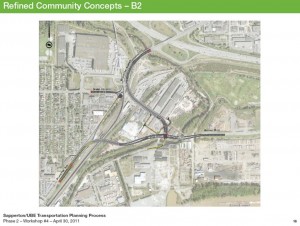 |
| click to zoom in. Do I have to keep saying this? |
This project takes most of the negatives of B1, with the exception that it doesn’t cause as much back-up on Brunette. As a trade-off, it impacts more New Westminster industrial land, builds a set of intersections with significant navigation challenges to cyclists (It took 10 minutes for me to show the TransLink representative that the routes for bikes here just didn’t work out). Worse, it completely cuts Braid Station off from the rest of the community and points east. This design also looks like it will cost TransLink 2 or 3 times as much as the original design, with that much more elevated overpass construction, much of it over working rail yard. This may represent a cost equal to the Evergreen Funding Gap.
Refined Concept E1:
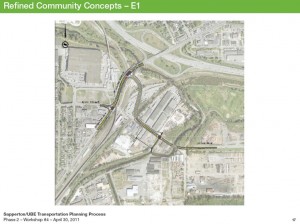 |
| Guess what happens when you click |
This concept definitely has more community support than the “B” concepts, mostly because it has much lower impact on the residential and commercial properties in Sapperton (but possibly a bigger impact on the Industrial properties is it meant to be servicing). TransLink has suggested the location of a new light-controlled intersection between the Freeway and Braid presents congestion challenges that may not be surmountable, and it is hard to argue against that point. Perhaps there is a creative solution to be found in creating an interchange where the intersection is currently shown on Brunette, but it got me wondering if it might just be easier to make it only two lanes instead of four. If the purpose is to bypass the level crossing at Braid, isn’t two lanes enough to still “free up traffic”?
Community Concept E2:
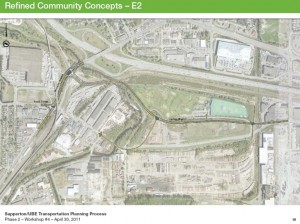 |
| Don;t click this one, or it will zoom in. |
This one did actually come from the community. There are a few problems with how it was worked up by TransLink (mostly, there is no need for the new intersection at the west end of the golf course – just direct traffic to the Braid Industrial area along the “old” United Boulevard and the Bailey Bridge, and direct the through-traffic along this new road). The big advantage is that the land being removed from the property tax rolls here is in Coquitlam, where they want this road, not in New West, where we don’t. TransLink suggested there were engineering challenges building a road on the old landfill (to which my answer was –yeah. So? Wasn’t Highway 1 being build on old landfills? And sections of the SFPR? And IKEA?). But the major point to make with this concept is that it looks better than E1 because it is closer to the Freeway. In fact, moving it to the north side of the Golf Course makes it look better yet. This road looks better the closer you push it to the Freeway, which again raises the question of why not just put the Trucks on the Freeway, and keep them off of local roads?
Refined Concept E3:
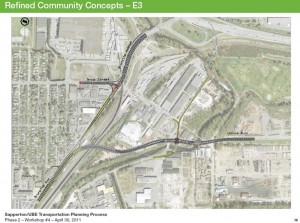 |
| is this caption redundant? |
Uniquely combines all the negatives of the other plans with increased cost, and no apparent gain. Dead in the water.
One concept that did not come up for discussion was presented by Voony on his Blog:
This offers all the advantaged of the “E”s, and actually frees up movement around the Braid interchange without increasing road capacity.
And it is not that unusual, and multi-lane roundabouts are now the MOT’s preferred method to deal with these type of geometrically-challenged intersections, or those that need smoother flow without increased road capacity… sound familiar? Voony even offered and example from France:
An example closer to home that eerily similar to the Brunette interchange issues can be found in Chilliwack.
Well, those are my opinions the “refined” options, but much of the Workshop was on the topic of mitigation details, and fancy garlands they plan to hang on the sides of the overpasses to make them pretty. My frustration is turning into a headache, so I will save that for another post…
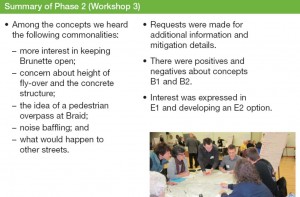
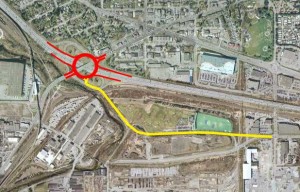
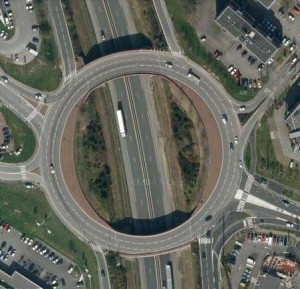
Thank you for continuing to document the process. I have been reading all your UBE posts and appreciate all the time and effort you are putting into them and into attending all the “polishing of concepts, engagement of the local residents, planning, visioning, and conversing.”
And I especially appreciate you calling it as it is: main issue is the lack of a justification for the project and “lack of a comprehensive plan to manage traffic west of the project.”
Thanks Mom!